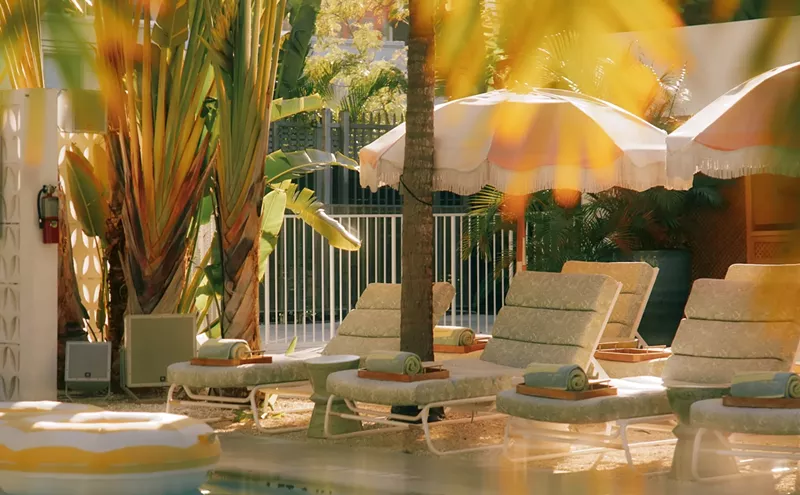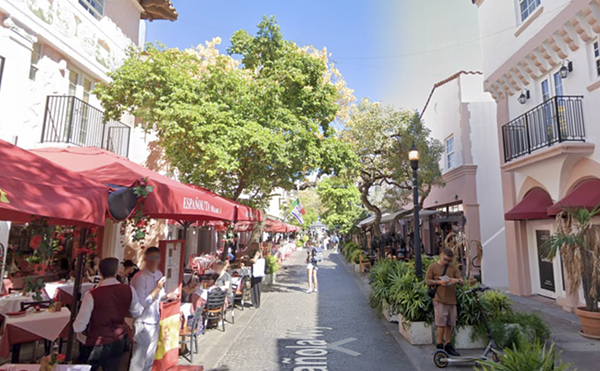The obvious contemporary example of this is Las Vegas. Writer Mark Katz asserts that the desert city "has literally transformed the hotel lobby into cinematic space, as if guests would öcheck into' a film as they enter the themed lobbies of the Mirage, Luxor, or MGM Grand, with narrative sequences of sinking galleons and exploding volcanoes."
We are more design-aware since the Sixties, when art's "environment" and "performance" permeated interior design with stars like Verner Panton and Luigi Colani creating "living experiments," and firms like Superstudio and Archizoom planning futuristic habitations and self-regulating environments.
Then there's cinema, our prime vehicle of cultural dissemination, which helped dramatize the hotel lobby. Perhaps you remember that cast of peculiar travelers striding through a lobby in the movie Grand Hotel, the epitome of Berlin's modern interior and exclusive privacy in the Thirties. Where else would a prefeminist Garbo utter, "I want to be alone"?
Who can forget that scene in Visconti's Death in Venice where a fading Gustav von Aschenbach (played by a bespectacled Dirk Bogarde) is able to hang around like a decadent flâneur in the lobby of the Hotel Des Bains on the Lido in Venice?
Or Antonioni's 1960 masterpiece L'Avventura, shot in the San Domenico Palace in Sicily, a site that has since become a landmark. More recently, in Sophia Coppola's Lost in Translation, Tokyo's Park Hyatt Hotel got a lead role along with Bill Murray and Scarlett Johansson. What's the fascination?
Hotels are no longer places simply to stop for the night; they are social laboratories that manufacture desire in constant permutation between reclusion and exhibitionism. Architect Rem Koolhaas, for example, sees our post-modern lobbies as "interfaces between the public and private." In other words, your hotel room is just a provisional stop to redirect ongoing encounters that begin in the lobby.
In Miami Beach we have an alluring coastal landscape packed with historic buildings whose main attraction is their Art Deco design, a style that turned modernism into fashion. But our Deco is unique in that it feels subtropical; its look is sleek and nontraditional without being ostentatious. Since the explosion of South Beach in the early Nineties, many of these superb buildings were given a second chance to shine. Ironically it was the destruction of one of the finest examples, the Henry Hohauser-designed New Yorker, that sparked widespread interest in preserving those that remained.
Preservation, however, has different meanings for idealists and opportunists. It's one thing to bring back a building's shell and infrastructure and hire an interior designer to make a statement that reflects a concept. It's quite another to do a mediocre, superficial makeover in hopes of getting a free ride thanks to your conscientious next-door neighbor. In South Beach, I've seen both.
Lately it's been all about the glitter. In magazines we often read about the pool, the penthouse, and the visiting celebrities. As an alternative I decided to take a look at the lobbies of some of the area's renovated larger hotels. The smaller ones, including many of the gems along Ocean Drive, have much more modest lobbies and must be viewed in a different way. For this review I favored morning visits, when the details (or lack thereof) are not embellished by the seduction of artificial light.
The restoration of Roy F. France's 1939 National (1667 Collins Ave.) is first-rate. This is what's called "historic" renovation, the idea being to bring back a building's past by being as faithful as possible to its original splendor.
As you walk through the doors on a long beige rug emblazoned with the letter "N," you notice the Tamara restaurant (peppered with replicas of works by Deco painter Tamara de Lempicka) and a spacious mezzanine featuring an attractive geometric handrail grille.
In the lobby most of the period furniture matches the polished gold terrazzo floor. Take a close look at the fixture work, including the aluminum air-conditioning registers, the elevator's polished metal door, and the period phone booth next to the front desk.
The National's bar and lounge area are true works of art, with sumptuous woodwork balanced by light-brown upholstered armchairs -- a subdued and urbane ambiance. The hotel makes good in elegance, comfort, and warmth. It feels authentic without being a literal reproduction. No wonder the National was honored by the Dade Heritage Trust and bestowed with the Miami Design Preservation League's top award.
One of the taller South Beach hotels is the Delano (1685 Collins Ave.), built in 1947 and designed by architect Robert Swartburg. It was refurbished in 1995 by one of the world's most recognized designers, Philippe Starck.
You've probably seen the spacious lobby with its chocolate wood floors against huge white columns leading to a corridor with vaporous white curtains. (Starck's game is to elicit curiosity and mystery.) There's an impressive collection of modern and contemporary signature pieces by Charles and Ray Eames, Alessandro Mendini, Starck, Gaetano Pesce, and more.
The Delano's haute contemporary design stands at the opposite extreme from the National's idea of a restored interior plan -- and it's equally legitimate (though not in the eyes of the Miami Design Preservation League, which has withheld its approbation). The main character here is the furniture, which makes you feel as if you're inside a museum, an impressive accomplishment, though it also lends a sense of remove. I felt a little edgy sitting on the Eames's spectacular "La Chaise," perhaps because of the way it was framed -- all by itself. (Why not place a complementary stool next to some of these important pieces?)
What the Delano does with furniture the Sagamore does with art. The motif here (1671 Collins Ave.) is white all over, but in general there's more attention to detail. Architect Albert Anis's 1948 design has undergone a renovation that is minimalist and clean, spacious and restful. Most accessories are white (upholstery, floor, walls), as is a huge Rasheed-like circular leather sofa on a white rug, under a grayish globe lamp next to huge floral photos by Austrian artist Tina Dietz.
Among the nice touches are end tables with metal trays (filled with oranges) and votive candle arrangements suggesting an environment of contemplative luminosity. The "mushroom" installation above the front desk by artist Roxy Paine is simply adorable and shows how viable and flexible fine contemporary art can be.
In addition to internationally known artists, the Sagamore displays work from important Miami artists. Stop by Mark Koven's 3-D "moving" photos, Jorge Pantoja's drawings inside a glass-and-wood shelf, and Rafael Salazar's photo collages in the lounge room.
The Sagamore's lobby exudes a relaxed sophistication, though at the time of my visit, the lobby's white rug showed signs of a late-night feeding frenzy. In 2003 the hotel was voted among the "Top Twenty Hottest Beach Resorts in the World" by Condé Nast Traveler.
Within easy walking distance is the Shore Club (1901 Collins Ave.), one of South Beach's latest à la mode destinations. The new design by David Chipperfield, among Britain's best-known minimalist architects, actually combines two hotels -- the 1949 Shore Club (whose columns still adorn the lobby) and the 1939 Sharalton.
The interior is spacious yet intimate, and highlights big and comfortable generic sofas covered with cream-colored fabric. The columns, dressed top to bottom in transparent curtains, proffer a diaphanous sense of meditation, heightened by lanterns over the greenish, lustrous floor. The idea is to make you feel as if the lobby (and you) are floating.
Beyond the front desk's glassy purple station you can see the patio and its blue columns. The contrast with the green-and-white interior works well. The "siren" motif mural, painted in dark gray against the light-beige wall, is also very appropriate. As a bonus, don't forget to visit (in the back of the hotel) star chef Nobu Matsuhisa's eponymously named restaurant, considered among the best sushi establishments in the nation.
The Shore Club's ingenious idea to use middle-of-the-road furniture in a cool interior is clever, though for my taste it's a bit tame. How about a pair of huge male/female Polynesian or African sculptures (which would be Deco-friendly) to break up the blandness? This interior is a reminder that nice design doesn't have to be too expensive, which brings me to another hotel, one that doesn't quite get it -- Murray Dixon's 1936 Tides (1220 Ocean Dr.).
An imposing building for the Ocean Drive hotel strip, the Tides presents a nice pink geometric entrance. Its interior, furnished in light beige, goes well with the fair-colored terrazzo floor and its geometric patterns. Though comfy, the canvas-covered furniture arrangement here seems too informal, almost lacking. I also have a problem with those tacky canvases in the rear, filled with crayon-handwritten quotations from that enfant terrible of the language, Oscar Wilde. My advice: If you love Wilde so much, color-Xerox an old edition's page, enlarge it, and frame it nicely. Aesthetic connoisseur that he was, Wilde would approve. (The hotel will soon be converted to condominiums, giving the new owners a chance to make changes.)
My final stop was L. Murray Dixon's Raleigh (1775 Collins Ave.). Built in 1940, the hotel was featured on the cover of Life magazine; its award-winning swimming pool was Esther Williams's favorite. The Raleigh was one of the first remodeled hotels on the Beach, and under new proprietor André Balazs (who also owns the luxe Chateau Marmont and Standard hotels in Los Angeles and the Mercer in SoHo), it has been redesigned in a way that retains its intimate, tropical Art Deco aura.
You'll enjoy the cozy little coffee café with its original metalwork; the intimate Bauhaus bar; its informal, island-inspired, fiber-woven furnishings; the large ceramic planters topped with svelte ferns; and above all its massive pink-coral front desk. To the rear of the lobby and elevated a couple of steps is a darker but soothing lounge area with period pieces upholstered in green, the walls filled with celebrity guest photos.
In keeping with the cinema's affection for sleek hotel lobbies, the Raleigh's mood took me to a moment inside a lesser-known 1948 film noir in which I found myself watching Yvonne De Carlo, who sat across the lobby looking grand in her sultry taffeta dress. She returned my gaze and playfully smiled. Just as I'm about to make my move, a sweaty, creepy little Peter Lorre got in my way, whispered something in her ear, and together they ran off. I hated him for that, though in the end he would catch the bad guy.












